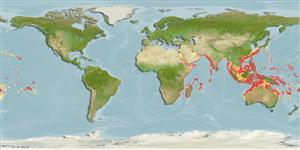Common names from other countries
Environment: milieu / climate zone / depth range / distribution range
Sinh thái học
; Mức độ sâu 0 - 900 m (Ref. 4). Tropical; 35°N - 32°S, 31°E - 134°W (Ref. 4)
Indo-Pacific: from South Africa to Hawaii, including Red Sea and Persian Gulf, from Japan to Australia.
Length at first maturity / Bộ gần gũi / Khối lượng (Trọng lượng) / Age
Maturity: Lm 7.8, range 8 - ? cm Max length : 40.0 cm TL con đực/không giới tính; (Ref. 4)
Minimum depth from Ref. 96667. It has a maximum total body length of 40 cm, and an average length less than 30 cm (Ref. 4). Maximum depth from Ref. 105426. It occurs in shallow water, from the sublittoral down to 15 m; in coral reef areas, often on seaward edges of the reef plateau; in clear water also in surf areas. The species is nocturnal and not gregarious; in daytime, it hides in crevices and cavities of the rocks (Refs. 4, 9773). In general, palinurids are mainly considered carnivores, usually feeding upon sluggish, easily captured animals where most material is eaten alive or freshly killed (Ref. 105260). Feeds on bivalve mollusks and sea urchins (Ref. 9773).
Members of the order Decapoda are mostly gonochoric. Mating behavior: Precopulatory courtship ritual is common (through olfactory and tactile cues); usually indirect sperm transfer.
Holthuis, L.B. 1991. (Ref. 4)
IUCN Red List Status (Ref. 130435)
CITES status (Ref. 108899)
Not Evaluated
Not Evaluated
Human uses
Các nghề cá: Tính thương mại
| FishSource | Biển chung quanh ta
Các công cụ
Các nguồn internet
Estimates based on models
Preferred temperature
(Ref.
115969): 9.8 - 22.9, mean 15.4 (based on 644 cells).
Thích nghi nhanh
Trung bình, thời gian nhân đôi của chủng quần tối thiểu là 1.4 - 4.4 năm (K=0.27; tm=3).
Prior r = 1.19, 95% CL = 0.79 - 1.79, Based on 1 data-limited stock assessment.
Vulnerability
Low to moderate vulnerability (30 of 100).
